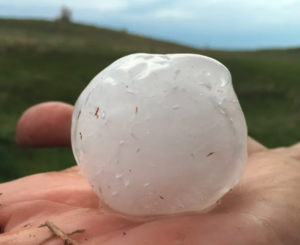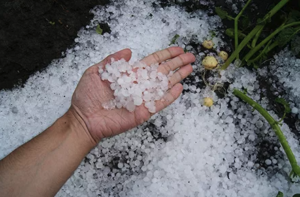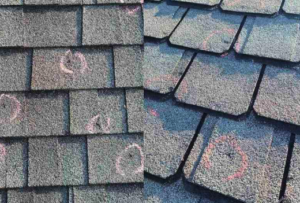A hail storm can be a frightening and damaging experience for homeowners. When hailstones fall, they can cause significant damage to a home’s roof, leading to leaks, cracks, and other issues. While some hail storms may cause only minor damage, others can be severe enough to require extensive repairs or even a full roof replacement.
West Michigan homeowners who have experienced a hailstorm may be wondering what kind of damage to expect and what steps they should take to protect their home. Understanding the effects of a hailstorm on a home’s roof can help homeowners prepare for the worst and take the necessary steps to minimize damage and protect their investment.
West Michigan Roofing has dealt with situations ranging frrom dented shingles to punctured membranes, a hailstorm can cause a wide range of damage to a home’s roof. While some damage may be visible right away, other issues may not become apparent until weeks or even months later. In this article, we will explore the effects of a hailstorm on a home’s roof, including the types of damage that can occur and what homeowners can do to protect their property.
What is Hail and How Does it Form?
Hail is a type of precipitation that occurs during thunderstorms. It is formed when updrafts in the storm carry raindrops high into the atmosphere, where temperatures are below freezing. The raindrops freeze into ice pellets and are carried up and down in the storm, accumulating layers of ice until they become too heavy for the updrafts to support and fall to the ground.

The size of hailstones can vary greatly, from small pellets the size of peas to large balls the size of softballs. The largest hailstone ever recorded was 8 inches in diameter and weighed nearly 2 pounds. Hailstorms can cause significant damage to homes, particularly to roofs.
There are several factors that can affect the size and intensity of a hailstorm. The strength of the updrafts, the temperature and moisture content of the atmosphere, and the presence of other weather systems can all play a role in the formation of hailstones. Hailstorms are most common in areas with warm, moist air near the ground and cold air at higher altitudes.

How Does Hail Damage a Roof?
When hailstones fall from the sky, they can cause significant damage to a home’s roof. The size and speed of the hailstones, as well as the type of roofing material, can all impact the extent of the damage.
As hailstones impact the roof, they can cause dents, cracks, and punctures in the shingles or other roofing materials. This can weaken the roof’s structure and make it more susceptible to leaks and other types of damage.
In addition to physical damage, hail can also cause granule loss on asphalt shingles. Granules are the small, sand-like particles that cover the surface of the shingles and protect them from UV rays. When hailstones hit the roof, they can knock off these granules, leaving the shingles exposed to the elements and more vulnerable to damage.
Overall, the effects of a hail storm on a home’s roof can be significant and costly to repair. It is important for homeowners to inspect their roofs after a hail storm and address any damage as soon as possible to prevent further problems.
Signs of Hail Damage on a Roof
After a hail storm, it is important to inspect your roof for damage. Hail damage on a roof can be difficult to spot from the ground, but there are some signs that homeowners can look for to determine if their roof has been damaged by hail.
One of the most common signs of hail damage on a roof is dents or divots in the shingles. These dents can be small, but they can also be large enough to cause cracks in the shingles. Homeowners should also look for missing or cracked shingles, as well as granules that have been knocked off the shingles.
Another sign of hail damage is damage to the roof vents or flashing. Hail can dent or crack these components, which can lead to leaks and water damage inside the home. Homeowners should also check for damage to gutters, downspouts, and other exterior components of the home.
It is important to note that not all hail damage is immediately visible. Small cracks or dents in the shingles can lead to leaks over time, which can cause significant damage to the home. Homeowners should consider having their roof inspected by a professional after a hail storm to ensure that any damage is identified and repaired.
Steps to Take After a Hail Storm
After a hail storm, it’s important to inspect your roof for any damage. Here are a few steps to take:
- Check for any leaks or water damage inside the home.
- Inspect the roof for any visible damage, such as dents or missing shingles.
- Take pictures of any damage for insurance purposes.
- Contact a professional roofing contractor to assess the damage and provide a repair estimate.
- File an insurance claim if necessary.
It’s important to take action quickly after a hail storm to prevent further damage and ensure the safety of your home and family. By following these steps, you can address any damage to your roof and get it repaired as soon as possible.
Preventing Hail Damage to Your Roof
While hail storms can be unpredictable, there are a few steps homeowners can take to minimize the risk of damage to their roof:
- Use impact-resistant roofing materials: Consider using materials that are specifically designed to withstand hail damage, such as metal, concrete, or asphalt shingles with a Class 4 rating.
- Trim trees near the house: Overhanging branches can break off during a storm and cause damage to the roof. Keep trees trimmed and away from the roof as much as possible.
- Regularly inspect and maintain the roof: Check the roof for any signs of damage or wear and tear, and repair any issues promptly. This can help prevent small problems from turning into larger ones during a hail storm.
- Install protective coverings: Consider installing hail guards or screens over skylights, vents, and other roof openings to prevent hail from entering the home.
While these steps may not completely eliminate the risk of hail damage, they can help reduce the likelihood and severity of damage to your home’s roof. By taking proactive measures to protect your roof, you can help ensure that your home is better prepared to weather any future storms.
How likely are you to experience a roof damaging hail storm in West Michigan?

West Michigan’s History of Hail Storms: A Look Back
Hail storms are a common occurrence in West Michigan. These storms can cause significant damage to crops, homes, and vehicles. Understanding the history of hail storms in the region can provide insight into the frequency and severity of these events.
West Michigan has a long history of hail storms, with the first recorded event dating back to the 1800s. Since then, there have been numerous hail storms that have impacted the region, with some causing millions of dollars in damage. The frequency and severity of these storms can vary greatly from year to year, making it difficult to predict when and where they will occur.
Despite the challenges of predicting hail storms, researchers continue to study the patterns and causes of these events in West Michigan. By understanding the history and science of hail storms, communities can better prepare for the potential impact of these weather events and minimize the damage they cause.
What Causes Hail Storms in West Michigan

West Michigan is no stranger to severe weather, including hail storms. Hail is formed when updrafts in thunderstorms carry raindrops high into the atmosphere, where they freeze into ice pellets. These pellets grow larger as they are carried by the updrafts, eventually becoming heavy enough to fall to the ground as hailstones.
Several factors contribute to the formation of hail storms in West Michigan. One of the primary factors is the region’s location in the Midwest, which is known for its volatile weather patterns. Cold air masses from Canada often collide with warm, moist air from the Gulf of Mexico, creating the perfect conditions for severe thunderstorms and hail storms.
Another factor is the presence of the Great Lakes, which can create instability in the atmosphere and contribute to the formation of thunderstorms. When warm, moist air rises over the cooler air above the lakes, it can create updrafts that lead to thunderstorm development and hail formation.
Finally, topography can also play a role in hail storm formation in West Michigan. The region’s varied landscape, including hills, valleys, and bodies of water, can create different atmospheric conditions that contribute to the development of thunderstorms and hail storms.
Notable Hail Storms in West Michigan History
West Michigan has seen its share of hail storms throughout history. Some of the most notable hail storms in the region include:
- May 30, 1896: A hail storm hit Grand Rapids and the surrounding areas, causing significant damage to crops and property. The hailstones were reportedly the size of hen’s eggs.
- June 17, 1944: A severe thunderstorm hit Muskegon, bringing with it hailstones as large as baseballs. The storm caused extensive damage to homes, businesses, and vehicles.
- July 13, 1986: A hail storm hit the Holland area, causing damage to homes and vehicles. The hailstones were reported to be the size of golf balls.
- August 20, 2009: A severe thunderstorm hit the Grand Rapids area, bringing with it hailstones as large as tennis balls. The storm caused significant damage to homes, businesses, and vehicles.
While these hail storms were some of the most notable in West Michigan history, the region has seen many other hail storms over the years. It is important for residents to be prepared for severe weather and to take necessary precautions to protect themselves and their property.
Impact of Hail Storms on West Michigan Communities
Hail storms have had a significant impact on the West Michigan communities over the years. These storms have caused damage to properties, crops, and infrastructure, and have resulted in injuries and fatalities in some cases. One of the most significant impacts of hail storms is the damage they cause to homes, buildings, and vehicles. Hail can cause dents, cracks, and holes in roofs, siding, and windows, leading to water damage and other issues. The cost of repairing hail damage can be substantial, and many homeowners and business owners struggle to afford the repairs. In addition to property damage, hail storms can also damage crops and other agricultural assets. The impact of hail on crops can be devastating, leading to reduced yields or even total crop loss. This can have a significant impact on the local economy, as many West Michigan communities rely on agriculture as a major source of income. Hail storms can also disrupt transportation and infrastructure, leading to road closures, power outages, and other issues. This can cause significant inconvenience for residents and businesses, and can also impact emergency response times in the event of an emergency. Overall, the impact of hail storms on West Michigan communities can be significant and long-lasting. While there is little that can be done to prevent hail storms from occurring, communities can take steps to prepare for these events and minimize the damage they cause.
Preventing Damage from Hail Storms in West Michigan
Residents of West Michigan are no strangers to hail storms, which can cause significant damage to homes and vehicles. While it is impossible to completely prevent hail damage, there are steps that homeowners and drivers can take to minimize the impact of these storms.
One of the most effective ways to prevent hail damage is to make sure that your property is properly maintained. This includes regularly inspecting your roof for damage or wear and tear, and repairing any issues promptly. Additionally, homeowners can install impact-resistant roofing materials, such as metal or asphalt shingles, which can help to reduce the impact of hailstones.
Another way to protect your property from hail damage is to make sure that your trees are trimmed properly. Overhanging branches can be easily damaged by hail, which can then fall onto roofs or cars. By keeping trees trimmed, homeowners can reduce the risk of damage to their property.
For drivers, the best way to prevent hail damage is to avoid parking your car outside during a storm. If you must park outside, try to find a covered area, such as a parking garage or carport. Additionally, covering your car with a thick blanket or tarp can help to reduce the impact of hailstones.
Finally, homeowners and drivers should make sure that they have adequate insurance coverage to protect against hail damage. While insurance cannot prevent damage from occurring, it can provide financial protection in the event that your property is damaged by a hail storm.
Wrapping things up…
West Michigan has a long history of hailstorms that have caused significant damage to property and agriculture. The region’s climate, which is characterized by warm summers and cold winters, creates the perfect conditions for hail formation.
Over the years, hailstorms have caused millions of dollars in damage to crops, homes, and vehicles. Despite advances in technology and weather forecasting, it is impossible to predict when and where a hailstorm will occur. However, residents of West Michigan can take steps to minimize the impact of hail damage.
- Invest in hail-resistant roofing materials for homes and buildings
- Protect vehicles by parking them in garages or under covered areas during hailstorms
- Stay informed about weather conditions by signing up for alerts and monitoring local news and weather reports
While hailstorms can be destructive, they are also a reminder of the power of nature and the importance of being prepared for unexpected weather events. By taking proactive measures, residents of West Michigan can minimize the impact of hailstorms on their lives and property.

